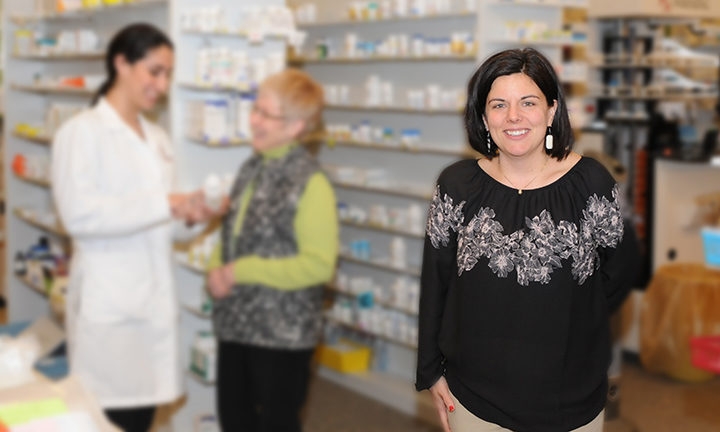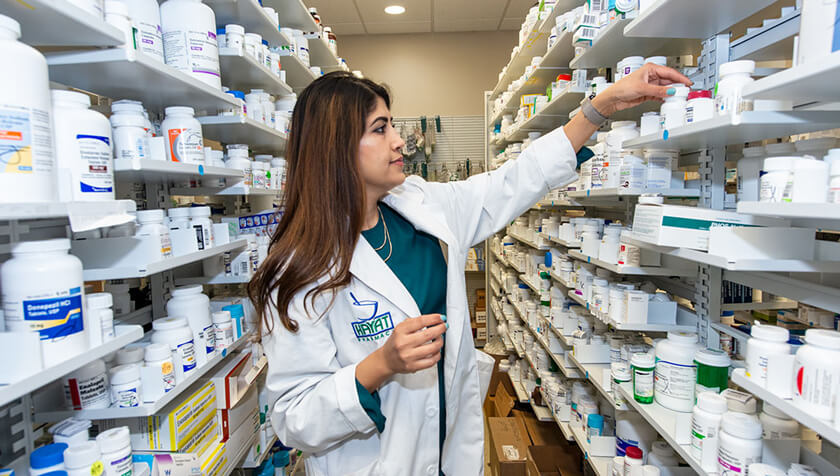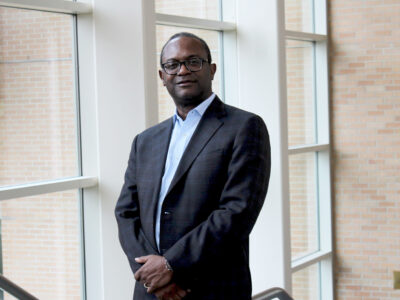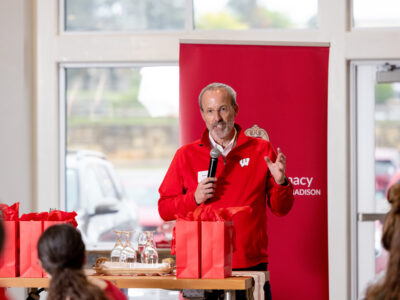
5
March

Michelle Farrell plays key role in expanding community pharmacy into new areas statewide
By Katie Ginder-Vogel
Patient care can be uniquely served by community pharmacists.
“Pharmacy students have a heightened interest in caring for patients from an ambulatory care standpoint,” says Michelle Farrell (BS ’99, PharmD ’00), owner and pharmacy manager of Boscobel Pharmacy. “I tell students that every single day, I get to do ambulatory care with the patients I serve. We have close relationships with our local clinic physicians and are truly making a difference in patients’ lives. You don’t have to reside in a clinic to offer those types of services.”
The close patient relationships and flexibility of community pharmacies is behind the launch of the Community Pharmacy Enhanced Services Network (CPESN® USA), a nationwide network of community pharmacies that coordinates patient care with broader care teams. The goal is to leverage the unique aspects of community pharmacies—regular, familiar interactions with patients and the ability to be nimble in their service offerings—to optimize medication use and enhance services for high-risk patients. Community pharmacies committed to delivering high-quality, patient-centered care that exceeds traditional pharmacy dispensing services are encouraged to join the network.
“CPESN USA creates a clinically integrated network of community pharmacies with which payers can contract to find the best service for patients,” says Farrell, the point person for CPESN Wisconsin, a sub-network of CPESN USA. “It also illustrates the expanded role community pharmacies can have in patient care, allowing us to integrate that into day-to-day care, with excellent documentation systems, so that we are ready when partners—providers and payers—ask us to be more involved in patient care.”
These days, when community pharmacies are expected to fill prescriptions quickly, despite declining reimbursements, Farrell has observed the pharmacy and business community’s recognition that to sustain themselves as businesses, community pharmacies need to offer clinical services and public health offerings, in addition to medication. As the only pharmacy in a rural area, Boscobel Pharmacy offers hospice care, comprehensive medication reviews, and other health and wellness services that promote medication adherence. The pharmacy partners with the School of Pharmacy to train pharmacists as a site for the School’s community residency program.
“The University of Wisconsin instills a true desire to lead and be innovative and forward-thinking.” —Michelle Farrell
CPESN Wisconsin aims to improve patient care and patient outcomes in Wisconsin and reduce overall health care costs, by integrating community pharmacists with the larger care team, including primary care physicians and specialty providers.
“Within Wisconsin pharmacy, we’ve always been very forward thinking,” says Farrell. “When CPESN USA launched with the target to develop nationwide networks across the states, we already had the Wisconsin Pharmacy Quality Collective (WPQC), a network of pharmacies across Wisconsin coordinated by the Pharmacy Society of Wisconsin (PSW).”
WPQC has provided the infrastructure for more than 10 years to collaborate with insurance payers in Wisconsin, including Wisconsin Medicaid, to facilitate payment for comprehensive medication reviews and other medication therapy management services. WPQC-accreditation, or another approved quality-based accreditation, is a requirement for inclusion in the CPESN Wisconsin network.
As the Wisconsin point person for CPESN USA, Farrell helps facilitate participation in work groups within the CPESN structure that include representatives from other CPESN networks in other states. One work group is doing a learning series on how to engage payers from a community pharmacy perspective. Another is doing an eight-session training on the perspectives that go into facilitating relationships between community pharmacies and insurers, to ultimately earn community pharmacies some value-based payment. Farrell also helps provide the agendas for monthly member meetings that address topics important to community pharmacists.
“We’re at a turning point right now, where we can share really relevant data with the rest of a patient’s care team to demonstrate our value as community pharmacists.” —Michelle Farrell
CPESN Wisconsin has grown to 50 pharmacies across the state since its 2015 launch, which was driven by Jake Olson, owner of Skywalk Pharmacy. Olson brought Farrell in as a collaborator, and over the past several years, Farrell has transitioned into the lead luminary role. Luminaries are pharmacists from CPESN member pharmacies who offer guidance to prospective and existing network members.
The Wisconsin Luminaries include several UW–Madison alumni, in addition to Farrell: Dimmy Sokhol (PharmD ‘13), a clinical pharmacist at Hayat Pharmacy; Abbigail Linde (PharmD ’11), managing pharmacist and owner of Hometown Pharmacy; Kristin Weiler-Nytes (PharmD ‘10), owner of Sniteman Pharmacy, Marv Moore (PharmD ’02), owner of The Medicine Shoppe in Two Rivers, and Matt Mabie (BS ‘98), co-owner of Forward Pharmacy in Cottage Grove. Another Wisconsin luminary, Rani Raju, a clinical pharmacist at Miller Pharmacy in Mukwonago, is an award-winning preceptor for UW–Madison PharmD students. Thad Schumacher, owner of Fitchburg Family Pharmacy, is also a Wisconsin luminary.
“I think the University of Wisconsin instills a true desire to lead and be innovative and forward-thinking, so the initial individuals to join are typically that group of people,” says Farrell. “At UW–Madison, we are taught total patient care, and one requirement for being a CPESN pharmacy is to offer a standard set of services within your pharmacy.”
Farrell explains that service set requirements lead to improved quality of care, better patient outcomes, and ultimately optimal medication use.
“Service sets require face-to-face counseling for medication synchronization, delivery services, and vaccination services,” she says. “Those all go together to enhance quality of care.”
CPESN pharmacies are required to document patient care longitudinally through the Pharmacist eCare Plan, a standard documentation system that allows pharmacies to communicate among each other.
“The eCare plan can be embedded within pharmacy dispensing software,” says Farrell. “It allows the pharmacist to indicate patient problems, status, and how we address problems, so that all our pharmacists know what we’ve communicated to a patient and can follow that up in future interactions.”
Farrell says that many community pharmacy patients visit their community pharmacy 10-20 times a year, far more than most people visit their doctors. Boscobel Pharmacy has four pharmacists, so consistent communication among the pharmacists and technicians improves patient care over time.
“It also elevates our technicians’ ability to perform at the top of their certification,” adds Farrell. “We’re utilizing technology to do that.”

Farrell, Sokhol, Linde, and PSW Vice President of Healthcare Quality Initiatives Kari Trapskin (BS ’99, PharmD ’00) wrote a grant for the Flip the Pharmacy program to implement clinical care across the CPESN member pharmacies in Wisconsin. Collaboration between CPESN Wisconsin and WPQC allows CPESN Wisconsin to leverage the existing WPQC infrastructure, training and workflow implementation material, marketing platforms, available Medicaid reimbursement, and statewide relationships in combination with CPESN support materials and outreach coaches to focus CPESN/WPQC pharmacies on providing longitudinal patient care services.
“The Community Pharmacy Foundation, in partnership with CPESN USA, has developed the Flip the Pharmacy program, and Wisconsin was awarded one of the grants,” says Farrell. “That work is further deepening the ability to operationalize and implement clinical care across the Wisconsin pharmacies that are part of it. They have a higher requirement of eCare Plan submissions, and we’re targeting hypertension.”
Farrell is excited about the opportunities to come.
“Within community pharmacies, we know our patients and have wonderful patient relationships,” says Farrell. “Over my career, our ability to document within software systems has gotten better.
“We’re at a turning point right now, where we can share really relevant data with the rest of a patient’s care team to demonstrate our value as community pharmacists. It’s a super exciting time.”




